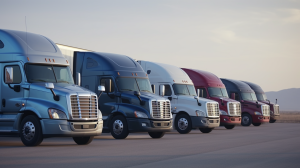Navigating the Route of the DRIVE Act: The Truck Speed Limiter Rule

The Truck Speed Limiter Rule, also known as the DRIVE Act, has sparked intense debate among various stakeholders in the transportation industry.
The Truck Speed Limiter Rule, a proposed regulation by the Federal Motor Carrier Safety Administration (FMCSA), has ignited a spirited discussion within the trucking industry. This rule proposes a speed cap on Class 7 and 8 trucks to ensure road safety. As we delve deeper into this legislation, we uncover the reasons behind its controversy, the potential implications for the trucking industry, and the broader public safety concerns.
This legislation is a part of an ongoing discussion regarding the safety measures in the trucking industry. Over the years, the FMCSA has been actively involved in improving safety regulations, and the Truck Speed Limiter Rule is seen as a significant step in this direction. The rule’s advocates assert that it would reduce the number of truck-involved accidents, subsequently improving public safety and fuel efficiency. The FMCSA’s stance is backed by data that suggests a correlation between higher truck speeds and increased crash rates.
However, the rule’s detractors argue that it might create a speed differential between trucks and other vehicles, leading to potential road safety issues. Moreover, they contend that the rule could negatively impact the trucking industry, leading to increased operational costs and possible disruptions in supply chains.
Understanding the DRIVE Act: A Challenge to the FMCSA Speed Limit Proposal
The Deregulating Restrictions on Interstate Vehicles and Eighteen-Wheelers (DRIVE) Act, H.R. 3039, is at the core of this controversy. Introduced by Rep. Josh Brecheen (R-OK) on May 2nd, this legislation directly challenges the FMCSA’s speed limit proposal and, if passed, could significantly reshape trucking industry legislation.
Enjoying our insights?
Subscribe to our newsletter to keep up with the latest industry trends and developments.
Stay InformedThe DRIVE Act advocates for state laws to regulate traffic flow, arguing against a federally mandated speed limit that Brecheen believes could negatively impact sectors of the agricultural and trucking industries. The Act emphasizes the potential adverse effects on economic productivity, suggesting that a federally imposed speed cap could lead to increased delivery times and cost inefficiencies.
Furthermore, the DRIVE Act raises concerns about the technical challenges associated with implementing speed limiters in trucks. The introduction of such technology would require significant alterations to the vehicle’s Electronic Engine Control Unit (ECU), potentially leading to increased maintenance costs for truck owners and operators.

On an annual basis, trucks without limiters had 16.4 crashes per 100 trucks versus 11 crashes per 100 trucks for trucks equipped with limiters
Supporters of the DRIVE Act: What’s the Argument Against Speed Limiters?
Several trucking associations have expressed support for the DRIVE Act, opposing the implementation of speed limiter technology. The Owner Operator Independent Drivers Association (OOIDA) is one such association that fears speed limiters could create a speed differential between cars and trucks, leading to potential road safety issues. Other supporters include the Western States Trucking Association and the National Association of Small Trucking Companies, all standing firm against the FMCSA Speed Limit Proposal.
These organizations argue that the proposed speed limiter rule would not only pose safety risks but also create operational challenges for truck drivers. They contend that the speed differential caused by speed limiters could lead to an increase in road accidents, contrary to the FMCSA’s safety objectives. Additionally, they highlight the potential for “rolling roadblocks” caused by slower trucks in both lanes, which could lead to increased traffic congestion and longer travel times.
Opposition to the DRIVE Act: Who’s Advocating for Speed Limiters?
On the flip side of the debate are organizations advocating for commercial vehicle safety, who want the FMCSA to persist in its work on the Truck Speed Limiter Rule. These groups include the American Trucking Associations (ATA), the Truckload Carriers Association (TCA), and the Alliance for Driver Safety and Security (The Trucking Alliance). They contend that a maximum speed limit for trucks would enhance public safety.
Anticipating the Future of the Truck Speed Limiter Rule
Predicting the future of the Truck Speed Limiter Rule is challenging, given the complexity of the political landscape in which it is situated. The legislation’s fate is intrinsically linked to the broader political dynamics surrounding interstate truck speed regulations.
Considering the current circumstances, the rule may:
- Gain traction in the Republican-led House of Representatives but
- Could face substantial resistance in the Democratic-majority Senate.

Proponents argue that restricting the speed of heavy-duty vehicles would reduce the number of truck-involved accidents and improve fuel economy.
The DRIVE Act’s future is uncertain and primarily depends on the balance of power in Congress. Even if the legislation doesn’t clear the Senate this time around, it may very well reemerge in a future session, especially if Republicans gain control over both chambers of Congress. It is a dynamic situation that reflects the complexities and uncertainties of legislative processes and the influence of political dynamics on regulatory matters.
What are the Implications of the Truck Speed Limiter Rule?
The Truck Speed Limiter Rule, if implemented, would have a profound impact on various stakeholders – from truckers and industry professionals to everyday citizens. As such, it’s essential to understand the different perspectives in this debate to form a well-informed opinion on the matter and anticipate how this legislation could shape the future of highway safety and the trucking industry.
For truck drivers, the rule could introduce new operational constraints that could affect their ability to do their jobs effectively and efficiently. Industry stakeholders, such as trucking companies, may need to consider the potential costs associated with implementing speed limiters and the implications for their business models. At the same time, the rule could offer benefits in terms of reducing accidents and improving fuel efficiency.
For the general public, the rule could enhance road safety by reducing the incidence of high-speed truck-related accidents. However, there may also be concerns about potential traffic disruptions due to slower-moving trucks on highways.
The Debate Continues: Stay Informed on the Truck Speed Limiter Rule

Opponents of the rule argue the opposite regarding safety, saying that the resulting speed differential between trucks and other vehicles would put all drivers at greater risk
The discourse around the Truck Speed Limiter Rule is multifaceted, involving numerous stakeholders and a myriad of considerations. With the DRIVE Act still under discussion and scrutiny, it remains crucial for all interested parties to stay abreast of developments and understand the potential implications for the future of trucking safety regulations.
This issue underscores the complexities inherent in balancing the need for road safety, operational efficiency in the trucking industry, and the broader economic implications. As the debate continues, staying informed will be key to understanding how this pivotal issue will evolve and what it might mean for the future of the trucking industry and road safety.
In Conclusion
The ongoing dialogue surrounding the DRIVE Act and the broader Truck Speed Limiter Rule represents a significant juncture in the interplay of technology, safety, and regulation within the trucking industry. It brings to the fore critical questions about how best to ensure road safety, the role of technology in achieving this goal, and the potential impacts on the trucking industry.
The future of the Truck Speed Limiter Rule remains uncertain, caught in the crosshairs of political wrangling, industry considerations, and public safety concerns. However, the rule – and the debate surrounding it – embodies the complexities of modern-day regulatory challenges. It serves as a stark reminder of the need for informed, balanced, and forward-looking discussions that consider the multifaceted implications of such measures on safety, industry operations, and wider societal impacts. As the debate unfolds, the ultimate outcome will undoubtedly have lasting implications for the trucking industry and beyond.
Key Points: The Speed Limiter Mandate Debate
- Safety Claims: Proponents of the speed limiter mandate argue that capping truck speeds will reduce the number of truck-involved accidents. They cite data showing that trucks without limiters had higher crash rates than those with limiters.
- Fuel Economy: Supporters also see speed limiters as a means to increase fuel economy, which would cut carriers’ costs and reduce emissions. According to the DOT’s calculation, tractor-trailers limited to 60 mph could save between $2,500 and $6,100 a year on fuel.
- Speed Differential Concerns: Opponents argue that the resulting speed differential between trucks and other vehicles would put all drivers at greater risk. They suggest that “traffic operating at or about the same speed is the safest traffic environment”.
- Possible Shift of Traffic: There’s a concern that limiting truck speeds could push more trucks off the Interstate system and onto other highways to avoid differential speed limits, which might lead to higher accident rates.
- Rear-End Collisions: The Owner-Operator Independent Drivers Association points out that in two-vehicle fatal crashes involving trucks and passenger cars, rear-end crashes are the most common. They caution that artificial speed differentials could cause more rear-end collisions with slower trucks.
- Counter-Evidence: Despite concerns about speed differentials, several studies conclude that slower speeds are generally safer. For example, a 2012 study found that as speeds become higher, the crash rate will also increase.
- Regulatory Process: The speed limiter mandate is currently undergoing the regulatory process, with public comments showing fervent opposition from those identifying as truckers.
Delve Further into Speed Limiter Mandate Discussions:
- Get the latest news and trends from the vibrant trucking industry, click here.
- Discover how the transport industry is evolving to enhance highway safety here.
- For more on how changes in trucking regulations can impact highway safety, click here.
- Understand how political decisions, laws, and policies are influencing the transport industry, visit this link.
- Learn more about the regulatory environment in the trucking industry and its impacts on truckers by clicking here.
External Perspectives and Industry Insights:
- For more information on the American Trucking Associations and their stance on speed limiters, visit their official website here.
- To learn more about the Owner-Operator Independent Drivers Association (OOIDA) and their viewpoint on speed limiters, click here.
- For more information on the Department of Transportation’s (DOT) role in regulating the trucking industry, visit their official website here.
- To understand the regulations governing speed limits in the U.S., visit the National Highway Traffic Safety Administration’s (NHTSA) website here.
- For more on the research into the relationship between speed and road safety, click here.
- H.R. 3039 – DRIVE Act: Read the Official Document here.





















